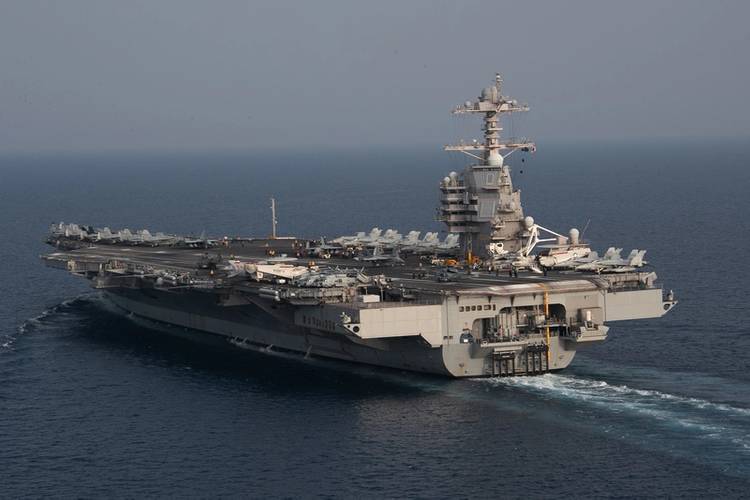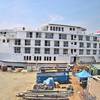The Need for [U.S. Navy Shipbuilding] Speed
The Navy wants, and needs, more ships; but it can’t build them fast enough.
While the U.S. Navy aims to achieve a 355-ship fleet, it is decommissioning older (and some not so old) ships at about the same rate it's adding new ones.
A Congressional Research Service report stated that, as of April 17, 2023, the Navy included 296 battle force ships. "The Navy projects that under its FY2024 budget submission, the Navy would include 293 battle force ships at the end of FY2024 and 291 battle force ships at the end of FY2028."
But there is progress, including modernizations of existing classes of ships and new construction programs.
Aircraft carriers
(CVN 78), which was commissioned in 2017. The second ship of the CVN 78 class, John F. Kennedy (CVN 79), is scheduled to enter service in 2025. Two more ships on the CVN 78 class are on order, CVN-80 (Enterprise) and CVN-81 (Doris Miller). All U.S. aircraft carriers are built by HII Corporate, formerly Huntington Ingalls Industries, at the company's Newport News Shipbuilding (NNS), of Newport News, Va.
The Navy completed the midlife "refueling complex overhaul" (RCOH) of USS George Washington (CVN 73) at NNS in May. According to a Navy press release, RCOHs are performed at the mid-point of a carrier's 50-plus-year lifespan, incorporating upgrades to propulsion equipment, infrastructure, and combat support systems. George Washington entered its RCOH on Aug. 4 2017,
The service is conducting a maintenance availability to enable the USS Nimitz (CVN 68) to complete one additional deployment. As the lead ship in a class of ten CVNs, Nimitz was commissioned in 1975 and built with a service life of 50 years. She is now expected to leave service in 2026.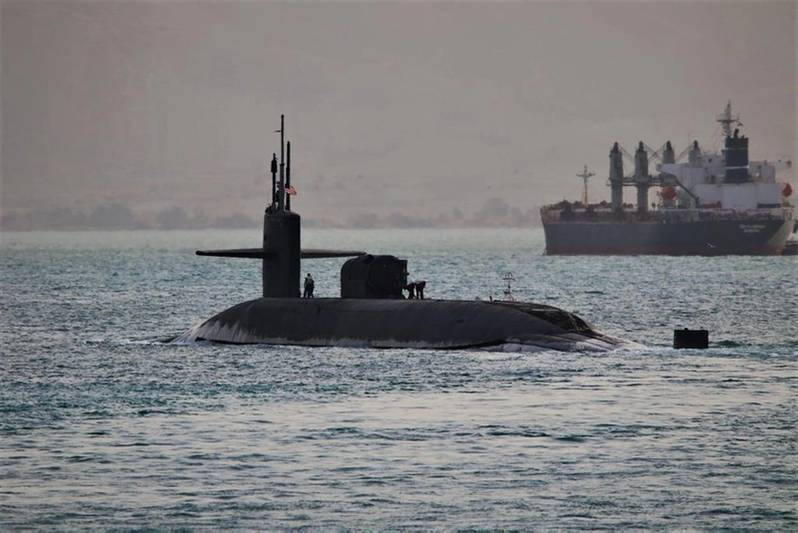 Guided-missile submarine USS Florida (SSGN 728) transits the Suez Canal enroute to the Red Sea, April 7, 2023. SSGNs can carry a dry deck shelter to deploy special operations forces. (U.S. Navy photo by Mass Communication Specialist 2nd Class Elliot Schaudt)
Guided-missile submarine USS Florida (SSGN 728) transits the Suez Canal enroute to the Red Sea, April 7, 2023. SSGNs can carry a dry deck shelter to deploy special operations forces. (U.S. Navy photo by Mass Communication Specialist 2nd Class Elliot Schaudt)
Submarines
The Navy has been procuring Virginia (SSN 774) class nuclear-powered attack submarines (SSNs) since FY1998, currently at a rate of about two per year, with 21 currently in commission, and a program of record of 66 submarines. The Virginia-class replaces the Los Angeles-class of attack boats, of which 62 were built between 1972 and 1996, with 26 still in service.
In addition to the Los Angeles and Virginia classes of attack boats, three boats of the Seawolf class were commissioned between 1996 and 2005 and are in active service (USS Connecticut (SSN 22) is currently undergoing major repairs following a collision with a seamount in 2021).
HII Corporate, formerly Huntington Ingalls Industries, christened Virginia-class submarine Massachusetts (SSN 798) at the company’s Newport News Shipbuilding division on May 8, while the future USS Iowa (SSN 797) was christened during a ceremony held at General Dynamics Electric Boat in Groton on 17 June.
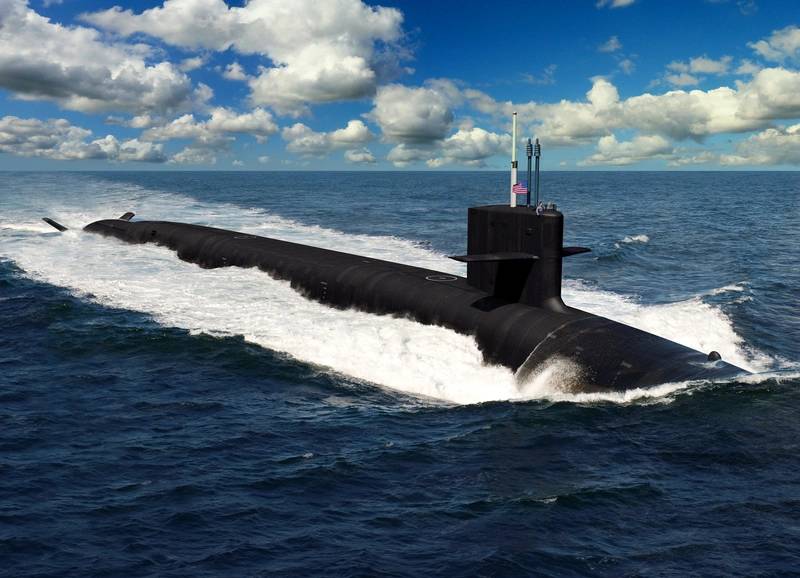 An artist rendering of the future Columbia-class ballistic missile submarines. The 12 submarines of the Columbia class are a shipbuilding priority and will replace the Ohio-class submarines reaching maximum extended service life. The construction of the lead ship, USS District of Columbia (SSBN 826), is underway. (U.S. Navy illustration/Released)
An artist rendering of the future Columbia-class ballistic missile submarines. The 12 submarines of the Columbia class are a shipbuilding priority and will replace the Ohio-class submarines reaching maximum extended service life. The construction of the lead ship, USS District of Columbia (SSBN 826), is underway. (U.S. Navy illustration/Released)
The first of the Trident ballistic missile submarines (SSBNs), USS Ohio (SSBN 726), was commissioned in 1981. Today, 14 of the 18 Ohio-class SSBNs support the strategic ballistic missile mission, while the first four were converted between 2002 and 2007 as conventional guided missile submarines (SSGNs) to carry 154 Tomahawk land-attack missiles and to support special operations forces (SOF). Ohio is scheduled to decommission in 2026. There are no plans to replace the Ohio's significant Tomahawk-carrying capacity with new SSGNs.
The Navy's top procurement priority is the replacement of the Ohio-class SSBNs with 12 new Columbia-class boats. The 14 Ohio's currently in commission serving in the strategic deterrent role (the remaining four are serving as SSGNs) will begin retiring in 2027 at a rate of one per year. Fewer Columbia's are required as direct replacements because the Columbia's will not require a lengthy mid-life refueling. While there are many design improvements, the Columbia-class will have the same length and displacement as the Ohios, and will be armed with the same Trident missiles, although the new boats will have 16 tubes instead of 24 on the Ohios. The lead ship—USS District of Columbia (SSBN 826) began construction in 2020 and is scheduled to join the fleet in 2031. General Dynamics Electric Boat is the prime contractor, although both EB and NNSY will share work in the program.
The U.S., UK, and Australian governments entered a unique security partnership in 2021 known as AUKUS, to help Australia acquire and operate its own force of SSNs. This would entail transfer of U.S.-built submarine to Australia while the program develops Australia's industrial base to be able to build ship in Australia. For the U.S., this provides both a boost and a strain to the industrial base that supplies components and services to design and build nuclear submarines for Australia at the same time industry is stretched to do the same for the U.S. Navy.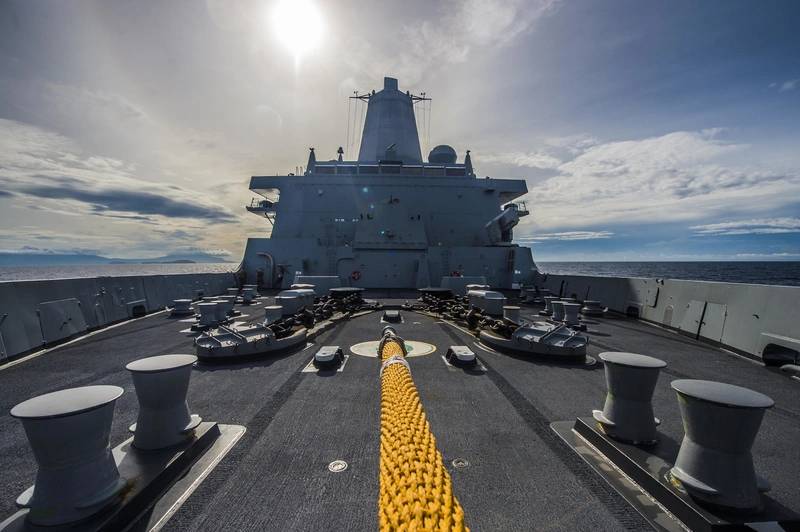 The amphibious dock landing ship USS Green Bay (LPD 20) transits the San Bernardino Strait. Green Bay, part of the Bonhomme Richard Expeditionary Strike Group, is operating in the U.S. 7th Fleet area of operations in support of security and stability in the Indo-Asia-Pacific region.
The amphibious dock landing ship USS Green Bay (LPD 20) transits the San Bernardino Strait. Green Bay, part of the Bonhomme Richard Expeditionary Strike Group, is operating in the U.S. 7th Fleet area of operations in support of security and stability in the Indo-Asia-Pacific region.
(U.S. Navy photo by Mass Communication Specialist 3rd Class Patrick Dionne/Released)
Amphibious fleet
Traditionally the Navy has operated Amphibious Assault Ships (LHA and LHDs), Landing platform docks (LPDs) and Landing Ship Docks (LSDs) as part of the Amphibious Ready Groups carrying Marine Expeditionary Units.
The Navy’s 355-ship force-level goal, released in December 2016, calls for a 355-ship fleet with 38 larger amphibious ships, comprised of 12 LHA/LHD-type ships, 13 LPD-17 Flight I class ships, and 13 LPD-17 Flight II class ships.
Marine Corps officials have supported a goal of 31 of at least amphibious ships, but current force projection plans do not show a force of 31 ships for the next 30 years.
The seven Wasp-class of 843-foot, 41,000-ton amphibious assault ships (LHD) (the eighth, USS Bonhomme Richard (LHD 6), had a catastrophic fire and is being scrapped), is joined by the two ships of the America class landing helicopter assault ships (LHAs). USS America is 844 feet long and displaces 45,700 tons, and joined the fleet in 2014. Two more are under construction, with a fifth LHA authorized. LHDs and LHAs are considered "big decks," and are essentially small aircraft carriers.
The Navy has 13 San Antonio-class LPDs in service, with the 14th and final ship under construction and fitting out prior to commissioning.
The 610-foot, 16,200-ton LSDs carry fewer Marines and have less extensive command and control facilities than 684-foot, 25,300-ton LPDs.
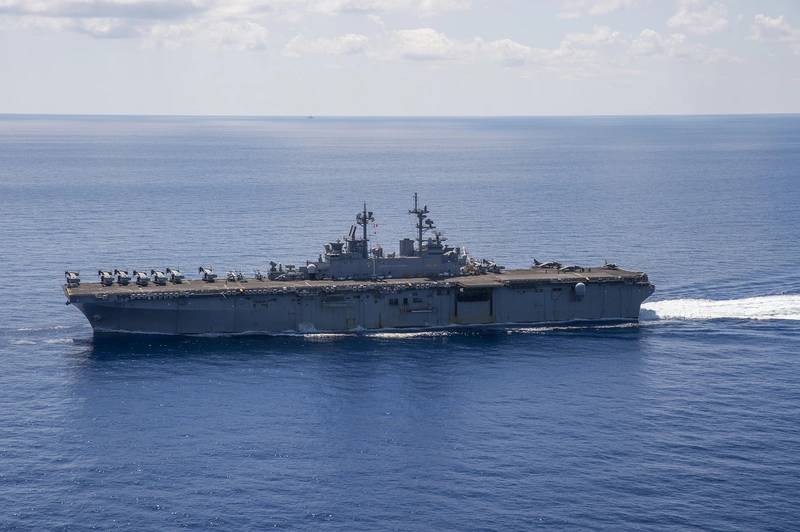 The amphibious assault ship USS Wasp (LHD 1) transits the Mediterranean Sea Sept. 24, 2016. Wasp is deployed with the Wasp Amphibious Ready Group to support maritime security operations and theater security cooperation efforts in the U.S. 6th Fleet area of operations.
The amphibious assault ship USS Wasp (LHD 1) transits the Mediterranean Sea Sept. 24, 2016. Wasp is deployed with the Wasp Amphibious Ready Group to support maritime security operations and theater security cooperation efforts in the U.S. 6th Fleet area of operations.
(U.S. Navy photo by Mass Communication Specialist 3rd Class Michael Molina/Released)
The Navy procured a total of 12 Whidbey Island/Harpers Ferry (LSD-41/49) class ships, which entered service between 1985 and 1998. Although the LSDs have an expected service life of 40 years, two of the ships were retired in 2021 and 2022, and the Navy wants to retire three more FY2024 budget proposes retiring three more in FY2024, leaving seven in service at the end of FY2024. Rather than replacing the LSDs with an entirely new class of ship, the replacement will be a more affordable version of the San Antonio-class called the LPD 17 Flight II. The first flight III, Harrisburg (LPD 30), is under construction, and the second, Pittsburg (LPD 31), has been procured.
A new class of ship, called the light amphibious warship (LAWS), now designated as the landing ship medium (LSM), is designed to support the Marines in distributed maritime operations (DMO) and Expeditionary Advanced Base Operations (EABO). The Navy talks about building 18, while the Marines say they need 35. These would be smaller than existing amphibious ships, and their numbers are not part of the 2016 force structure plan.
The Navy's amphibious ships are built at HII's Ingalls Shipbuilding of Pascagoula, Miss., although they could be built at other yards. The LSM could be built at second tier shipyards.
In May of this year the Navy released a Request for Information (RFI) to regarding the LSM program. The RFI asked potential builders if they have the resources and production capacity to build four LSMs per fiscal year, and if not, how many could they build. The RFI also queried if investments or shipyard improvements could be completed to enable increasing production capacity to four per year.
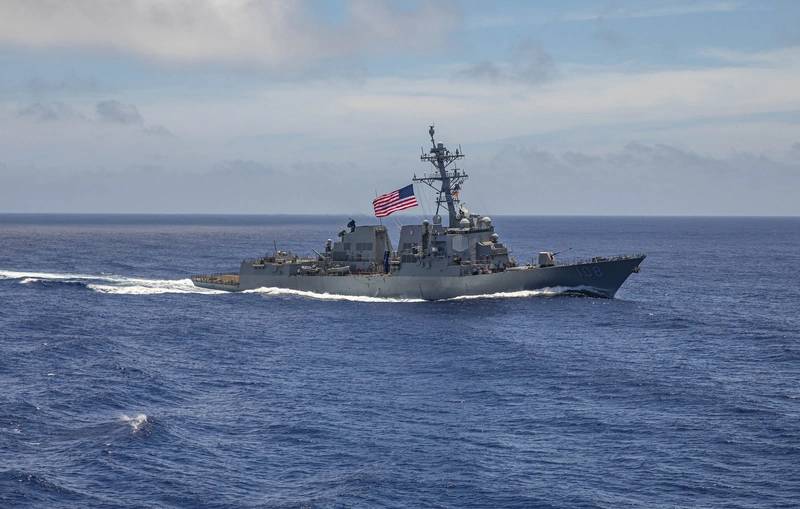 The Arleigh Burke-class guided-missile destroyer USS Wayne E. Meyer (DDG 108) steams in formation during an exercise in the U.S. Seventh Fleet area of operations on June 9, 2023.
The Arleigh Burke-class guided-missile destroyer USS Wayne E. Meyer (DDG 108) steams in formation during an exercise in the U.S. Seventh Fleet area of operations on June 9, 2023.
(U.S. Navy photo by Mass Communication Specialist 2nd Class Justin McTaggart)
Surface combatants
The Navy had planned to stop production of the DDG 51 class of guided missile destroyers and turn to the DDG 1000 Zumwalt class, a large but stealthy surface combatant with significant land attack capability and optimized to operate in the littorals. Originally planned for 32 ships, for a number of reasons, the Navy dropped the expensive Zumwalt program, stopping at three ships, and turned the DDG 51 production line back on.
The DDG 1000s were built around a 155-mm advanced gun system (AGS) that fired the long-range land attack projectile (LRLAP). The LRLAP ammo was also expensive, so that program and the AGS were also cancelled. Today, the DDG 1000 will be the platform for the new conventional prompt strike missile, a hypersonic weapon that is also planned for Virginia-class submarines.
The lead ship in its class, USS Arleigh Burke (DDG 51) was commissioned in 1991, and a total of 90 ships are now active. The production is still hot. The ships have been built in four different variants—Flights I, II, IIA, and production is now transitioning to the Flight III. The older ships have been kept relevant with periodic modernizations, so that even some of the oldest ships have some of the newest capabilities.
The Flight IIIs have the new SPY-6 Air and Missile Defense Radar, the newest baseline of the Aegis Combat System, and the newest iteration of the Surface Electronic Warfare Improvement Program (SEWIP), making them the most potent air defense destroyers in the world. The first Flight III, USS Jack Lucas (DDG 125) commissions this year. The Arleigh Burke-class guided-missile destroyer USS Wayne E. Meyer (DDG 108) steams in formation during an exercise in the U.S. Seventh Fleet area of operations on June 9, 2023.
The Arleigh Burke-class guided-missile destroyer USS Wayne E. Meyer (DDG 108) steams in formation during an exercise in the U.S. Seventh Fleet area of operations on June 9, 2023.
(U.S. Navy photo by Mass Communication Specialist 1st Class Nathan Laird)
Until the Navy starts building the new DDGX large surface combatants to replace the CG-47 Ticonderoga-class guided missile cruisers, the Flight IIIs will have to take on responsibility as the air defense commander for carrier strike groups. There are several plans floating around, but the Navy expects the last of the Ticonderoga's to decommission by 2027. Keep the aging cruisers combat capable is challenging and costly.
What the new Flight III DDGs don't have is margin to grow. There is simply no more room inside for new systems or to create more power. Since new weapons like lasers and rail guns require considerable amounts of energy on demand, a new ship is required to accommodate directed energy weapons and new power-hungry sensors.
The ultimate replacement for the CGs will be the DDGX large surface combatant, which will have the combat capability of the flight IIIs but an integrated power system and considerable space, weight, cooling and power (SWAP) for the systems of the future. The large surface combatant category includes the DDGs and CGs, and ultimately will replace both in the fleet. The Navy planned to procure 18 Flight III ships through fiscal year 2025, at which time DDG 51 production will make way for DDGX. The DDG 51 Flight I is about 8,200 tons displacement, and the Flight III is about 9,700 tons. A recent concept of the DDGX shows a displacement of 13,500 tons.
The Navy's new FFG 62 Constellation-class of guided missile frigates is based on the proven FREMM design from the Italian shipbuilder Fincantieri. They will be built at the Fincantieri Marinette Marine shipyard in Wisconsin. The program of record is 20 ships. The first four are under on order and the lead ship is construction now. The 496-foot, 7,300-ton frigates will have the Aegis combat system with the SPY-6 radar. The Navy has announced that the first 12 ships of the class will be based at Naval Station Everett in Washington State.
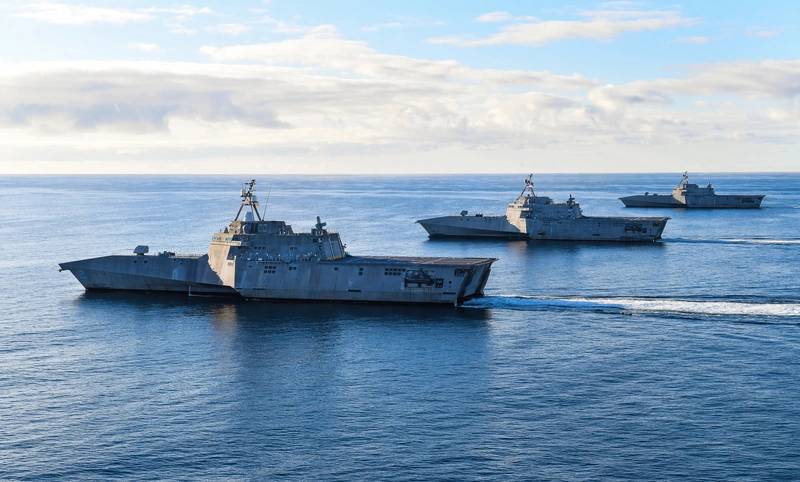 Three Independence variant littoral combat ships, USS Independence (LCS 2), left, USS Manchester (LCS 14), center, and USS Tulsa (LCS 16), right, sail in formation in the eastern Pacific.
Three Independence variant littoral combat ships, USS Independence (LCS 2), left, USS Manchester (LCS 14), center, and USS Tulsa (LCS 16), right, sail in formation in the eastern Pacific.
(U.S. Navy photo by Chief Mass Communication Specialist Shannon Renfroe/Released)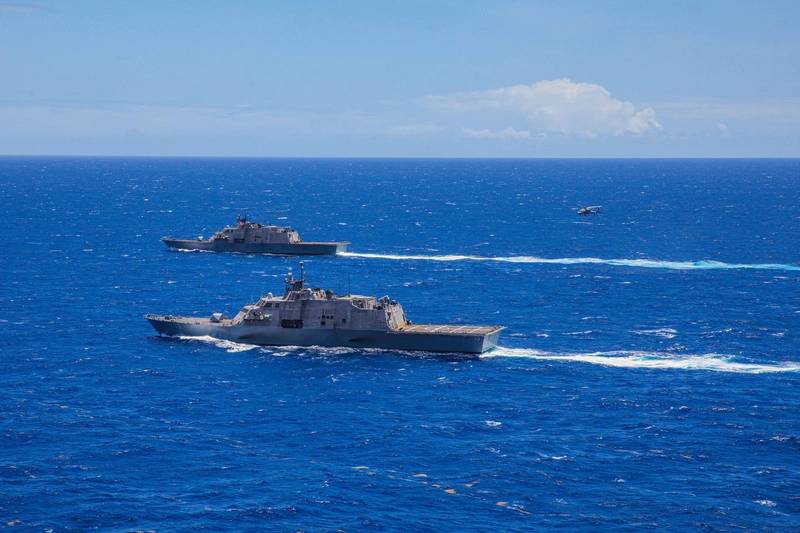 The Freedom-variant littoral combat ships USS Billings (LCS 15) and USS Wichita (LCS 13) and MH-60S Sea Hawk helicopters assigned to Helicopter Sea Combat Squadron (HSC) 28, Detachments 6 and 7 conduct counter narcotics operations in the Caribbean Sea, April 9, 2022.
The Freedom-variant littoral combat ships USS Billings (LCS 15) and USS Wichita (LCS 13) and MH-60S Sea Hawk helicopters assigned to Helicopter Sea Combat Squadron (HSC) 28, Detachments 6 and 7 conduct counter narcotics operations in the Caribbean Sea, April 9, 2022.
(U.S. Navy photo by Mass Communication Specialist 3rd Class Aaron Lau/Released)Like the DDG 1000, the littoral combat ship (LCS) started out as a good idea that was challenged by execution and shifting threats and warfighting priorities. LCS was originally conceived as a "truck" that could be configured with one of three modularized mission packages to address the asymmetric threats of small, fast armed boats, quiet diesel submarines and mines in littoral waters. Two very different hull designs were pursued, both able to carry the three different mission packages, allowing LCS to replace the mine warfare ships, patrol coastal ships and the FFG 7-class frigates. Today, the Navy and its allies and partners are focused on the threats posed by China and Russia. While the LCS still has great utility in conducting those focused missions, the more urgent need is for multi-mission warships that can operate in open-ocean warfighting environments.
The initial program was to build 52 ships, later cut to 32. The engineering plants of one of the two variants, the Freedom-class monohull, built by Lockheed Martin at Fincantieri Marinette Marine, has been plagued by complications with its combining gears. Some of the earlier Freedoms have been or will be decommissioned well before their expected service life. The Navy has also abandoned the ASW mission for LCS. That means the remaining ships will focus on general surface warfare mission and mine warfare, with the Independence variant focusing on the MIW mission and the Freedoms performing the surface warfare mission.
Obviously, there are other important auxiliary ship programs and new unmanned surface and undersea vessels in the works. The Navy is experimenting with large unmanned surface vessels (LUSVs, which are essentially offshore support vessels modified to operated without crews) as adjunct missile magazines to conduct remote engagements, as well as medium unmanned surface vessels (MUSVs) to extend the fleet's sensor network. Counting unmanned vessels, the Navy has said it might actually need a 500-ship fleet.
It better get busy building them.
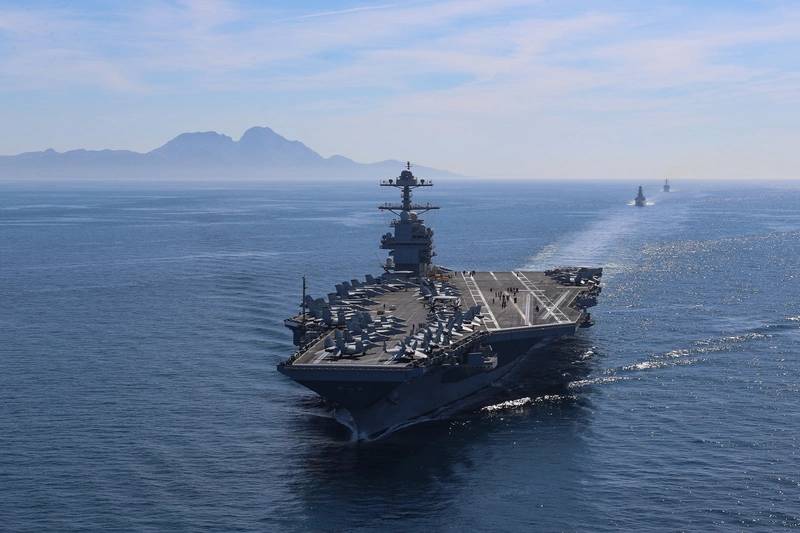 The world's largest aircraft carrier USS Gerald R. Ford (CVN 78), Italian frigate Alpino (F 594), and the Arleigh Burke-class guided-missile destroyer USS Roosevelt (DDG 80) transit the Strait of Gibraltar, June 15, 2023.
The world's largest aircraft carrier USS Gerald R. Ford (CVN 78), Italian frigate Alpino (F 594), and the Arleigh Burke-class guided-missile destroyer USS Roosevelt (DDG 80) transit the Strait of Gibraltar, June 15, 2023.
(U.S. Navy photo by Mass Communication Specialist 2nd Class Jackson Adkins)





